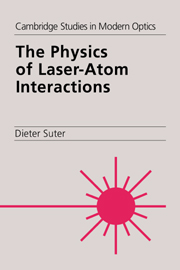Book contents
- Frontmatter
- Contents
- Preface
- Symbols and abbreviations
- 1 Introduction
- 2 Two-level atoms
- 3 Three-level effects
- 4 Internal degrees of freedom
- 5 Optical pumping
- 6 Optically anisotropic vapours
- 7 Coherent Raman processes
- 8 Sublevel dynamics
- 9 Two-dimensional spectroscopy
- 10 Nonlinear dynamics
- 11 Mechanical effects of light
- References
- Index
5 - Optical pumping
Published online by Cambridge University Press: 13 October 2009
- Frontmatter
- Contents
- Preface
- Symbols and abbreviations
- 1 Introduction
- 2 Two-level atoms
- 3 Three-level effects
- 4 Internal degrees of freedom
- 5 Optical pumping
- 6 Optically anisotropic vapours
- 7 Coherent Raman processes
- 8 Sublevel dynamics
- 9 Two-dimensional spectroscopy
- 10 Nonlinear dynamics
- 11 Mechanical effects of light
- References
- Index
Summary
After the brief discussion of the internal degrees of freedom of atomic systems, we give an overview of how these variables can acquire nonvanishing average values in an ensemble of atoms. Optical pumping was one of the first experimental schemes that allowed physical systems to be pushed far from equilibrium through the interaction with light, a direct consequence of angular momentum conservation and the symmetry properties of the interaction between atoms and radiation.
Principle and overview
Phenomenology
Optical pumping (Happer 1972) is one of the earliest examples wherein optical radiation qualitatively modifies the properties of a material system. In its original implementation, it corresponds to a selective population of specific angular momentum states, starting from thermal equilibrium.
In the idealised process depicted in Figure 5.1, the light brings the atomic system from the initially disordered state, in which the populations of degenerate levels are equal, into an ordered state where the internal state of all atoms is the same. If we consider only the material system, it appears as if the evolution from the initially disordered state into an ordered state, where the population of one level is higher than that of another level, violated the second law of thermodynamics. This process does not proceed spontaneously, however. It is the interaction with polarised light that drives the system and increased disorder in the radiation field compensates for the increase in the population difference in the material system (Enk and Nienhuis 1992).
- Type
- Chapter
- Information
- The Physics of Laser-Atom Interactions , pp. 160 - 202Publisher: Cambridge University PressPrint publication year: 1997
- 1
- Cited by

